Juggling careers: science and teaching in Germany Inspire article
Jörg Gutschank tells Vienna Leigh how his circus skills inspired him to take up teaching and saw him through his training – and how they help in the classroom.
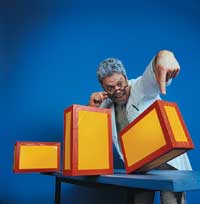
magic boxes, as a ‘professor’
in the Physikanten physics
shows
Image courtesy of Wolfgang
Herzberg
When you’re a teacher, it helps to have a cool hobby. One friend of mine, a geography teacher, spends her weekends as a resident DJ in a nightclub – and needless to say, she never gets accused of being over the hill. Nothing demands instant awe and respect like the discovery that a teacher has a secret exciting life going on after hours.
That’s something that Jörg Gutschank knows all about, too. When he’s not teaching physics, mathematics and computer science at a German secondary school, the Leibniz-Gymnasiumw1, you’ll find him juggling, riding a unicycle or even performing daredevil stunts on a flying trapeze!
“Juggling, cabaret and circus skills have always been a hobby of mine, even when I was studying physics – or maybe because of that,” says Jörg, who started teaching in secondary school in 2004. “During my PhD a friend and I had the idea to combine our hobbies with our profession – we were both physicists – and in 1999 we were inspired when we saw an advertisement for a festival called ‘Physics on Stage’w2 being held at the European Organization for Nuclear Research [CERN] in Geneva.”
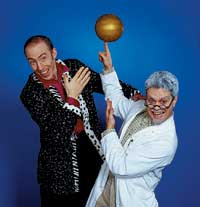
Herzberg
Jörg and his friend, Marcus Weber (né Hienz), decided to develop a physics show to contribute to the four-day festival, which was being held for the first time in November 2000 and comprised presentations, performances and workshops from physics educators and scientists from 22 countries. “We were thrilled that our show, ‘A top, a buoy and a ping-pong ball’,was selected for an on-stage performance at the festival,” says Jörg. “It was an interactive show involving experiments on angular momentum, aerodynamics and buoyant forces.”
From that moment, the pair spent days and nights preparing the show. “We wrote a script and hired a professional director for our rehearsals,” remembers Jörg. “We bought equipment, planned and built experiments, and our preparations were even recorded by journalists for a television broadcast!”
The final test was the dress rehearsal at the University of Dortmund, after which they had to pack all the equipment and send it to CERN for the big event. “This first Physics on Stage festival was a great and inspiring experience,” says Jörg. “I met many teachers who were eager to exchange their wonderful ideas about teaching and about physics.”
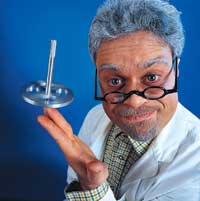
Herzberg
The show was so successful that Jörg and Marcus went on to found Physikanten & Cow3, a company which produces and performs physics shows at science festivals, museums and schools and for companies all over Europe. Themes such as the greenhouse effect, acoustics, electricity and fire are brought to life with props, costumes and special effects. The performances are a mix of comedy, spectacular experiments and audience participation. Physikanten have appeared several times on German TV and in 2008 performed their biggest show ever, an open-air event at the Paul Scherrer Institut near Zürich.
While Marcus stayed to run the company, Jörg was inspired to follow a different path. “After three brilliant years I decided that I really wanted to be a teacher, because I wanted to carry on working with people and do something useful for society, and so I applied for a scheme ‘Seiteneinstieg’, which allows scientists to move into teacher training,” he says.
As well as his core subjects, Jörg now teaches science and robotics at his school, a German upper secondary school or Gymnasium. “Personally, I prefer to decide what I teach. For this reason I prefer my new subjects to the traditional subjects, physics and mathematics, since there are no official curricula for science and robotics,” he says. “It’s great to have this freedom of choice and I tend to pass it on to my students by having them choose the details of what they want to do. That’s only possible in subjects without an official curriculum.”
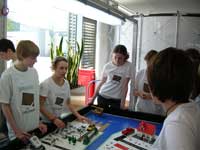
Gutschank
This means that Jörg and his colleagues have the chance to set up and plan special projects, which is where his creative edge comes in useful again. “My first project was about toys, and it was great fun to combine my ideas with those of my 5th and 6th year pupils [aged 10-12],” he says. “We built little rockets, a boat with a steam engine, and a geyser. Some pupils wanted their hamster to produce electricity with a generator from a bicycle – but for the sake of the hamster, we had only one short session of five minutes doing that!
“In another project, the children had to find out things about their body. They answered questions such as why we need two eyes by playing with a ball and closing one eye. This way the pupils could see the difference between trying to catch with one eye or with two.”
Teaching these subjects is made possible due to the special profile of the school, which offers additional bilingual and scientific tuition and which, from this term onwards, is an IB world school. “This means we’ll also be teaching the International Baccalaureate diploma programme in addition to the German leaving certificate [Abitur],” says Jörg. “Since we’re only just starting, we’ll be able to teach very small groups, which I prefer. I’ll be giving a physics course to only five students – four of whom are female, incidentally – and I’m looking forward to teaching such a small group.”
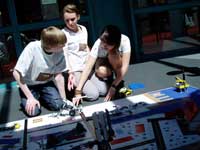
Gutschank
Although such working conditions are to be envied, Jörg agrees that there are some very particular challenges still to be overcome in teaching science. “I think it’s most important that we don’t give the impression that science is something finished which has to be learnt by heart, but that it’s something which is evolving and which needs constant questioning,” he says. “This can only work when the teacher admits to the students that he doesn’t know everything and that the point is not to know but to question, and to look for ways to solve problems. Involving everyday things and demonstrating the science behind students’ day-to-day lives is a great way of inspiring minds that ask questions about everything.
“A positive feeling towards science comes, I think, from this impulse to ask questions – an impulse which is inspired by the teacher. Career decisions are influenced by the attitude towards the subject and the teacher, so a positive feeling and a good relationship makes it more likely that a student will decide to pursue a scientific career.”
Web References
- w1 – The website of the Leibnitz Gymnasium is: www.leibniz-gym.de
- w2 – In 2005, the Physics on Stage science teaching festival was extended to Science on Stage. The sister project of Science in School, Science on Stage, was organised by the seven research organisations of EIROforum (www.eiroforum.org) and supported by the European Commission. The project has now developed further into Science on Stage Europe. For more information, see: www.scienceonstage.net and www.scienceonstage.eu
- w3 – To learn more about the Physikanten & Co, see: www.physikanten.de
Resources
- For more information about Jörg, see his website: www.school.gutschank.eu
Review
This article offers an interesting view of the odd routes people may take into teaching. It has given me ideas for working with our dance and sports departments to illustrate some applications of physics. I particularly like Jörg’s emphasis of the importance of the question, not the answer.
Devon Masarati, UK





